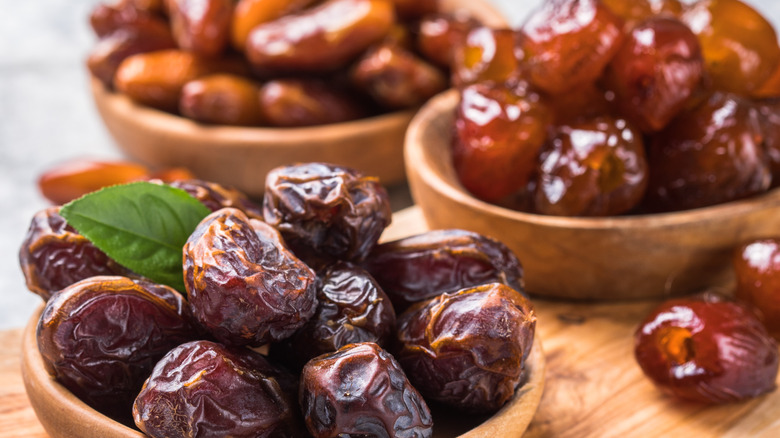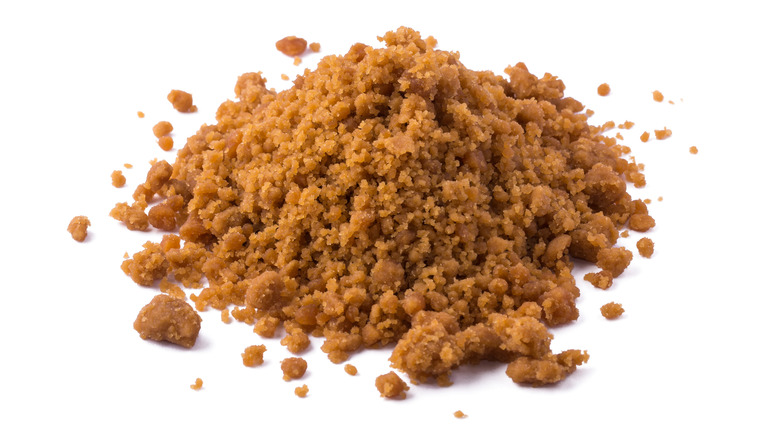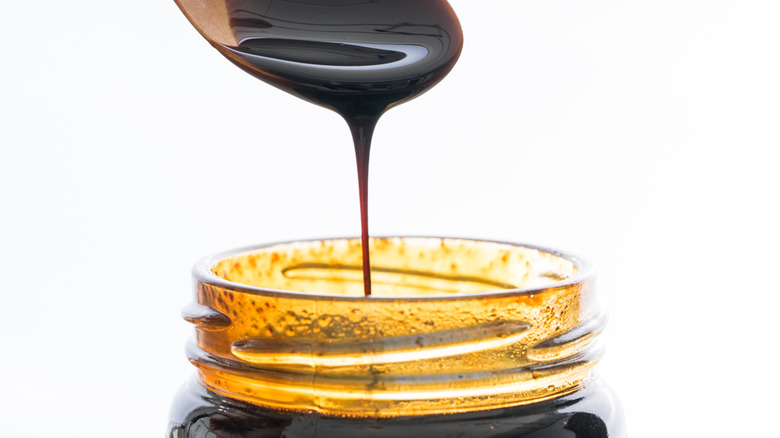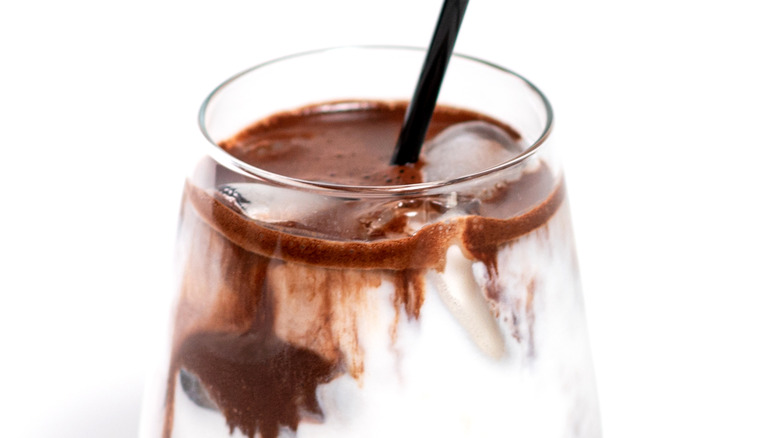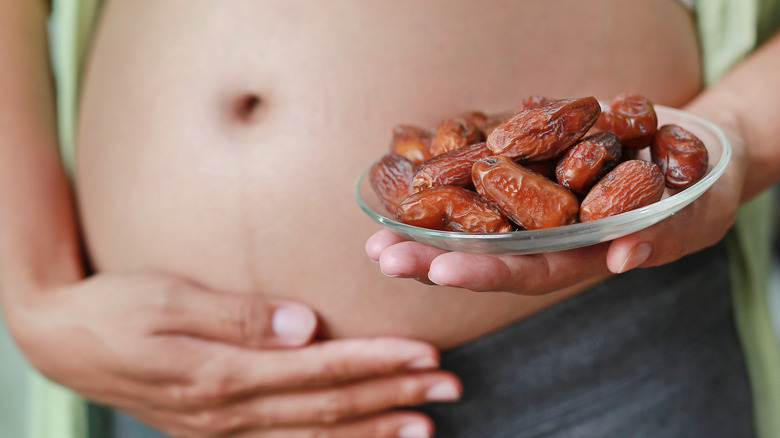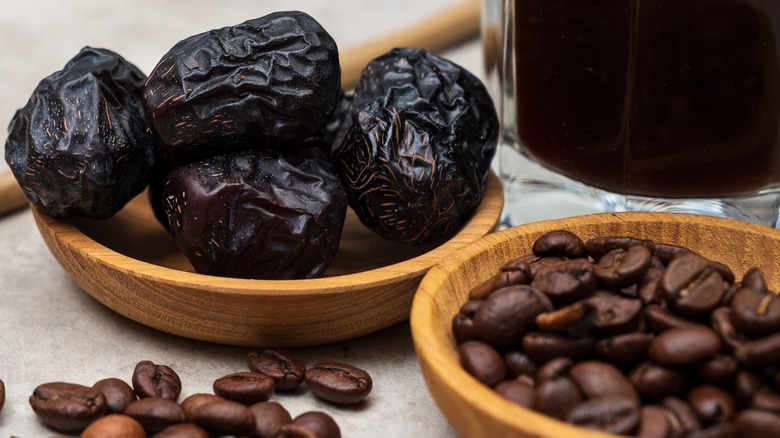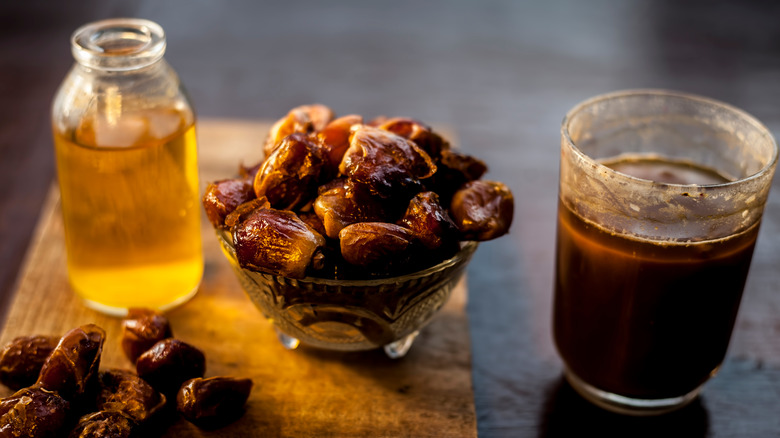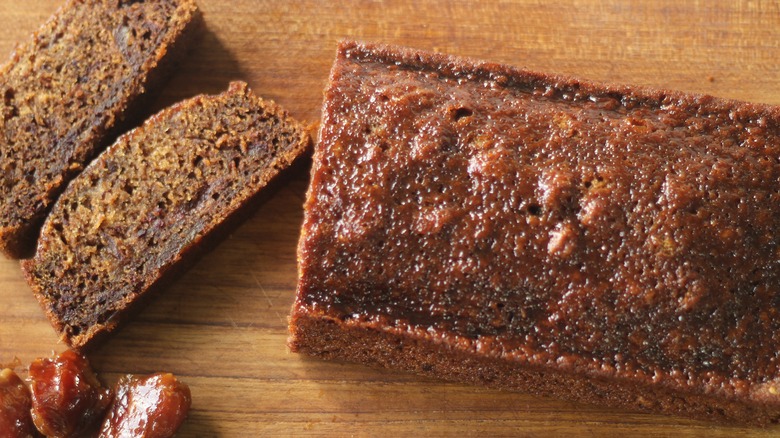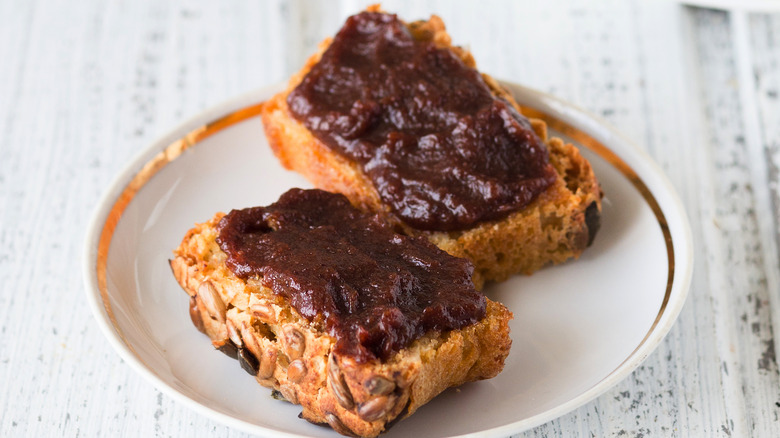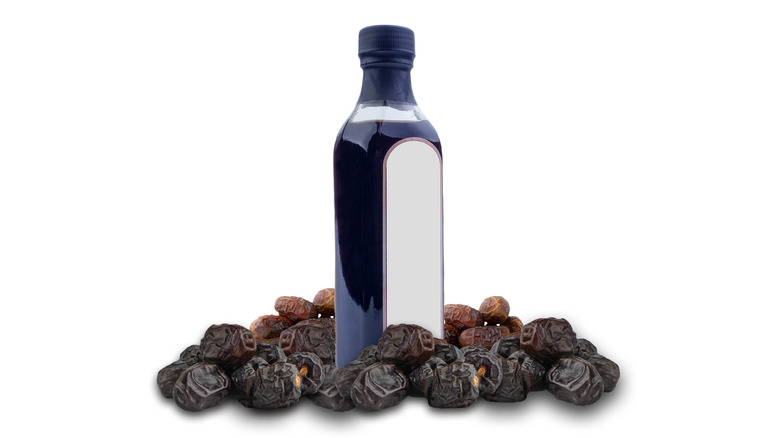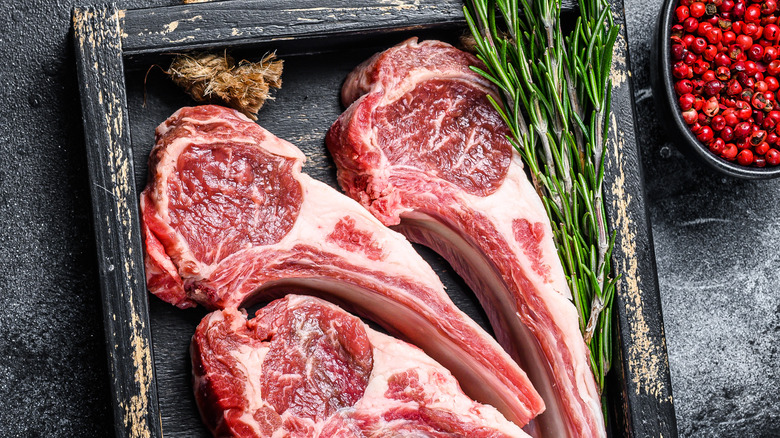10 Interesting Ways You Never Thought To Use Dates
According to National Geographic, there are over 3,000 types of dates, including popular varieties such as deglet noor and medjool. The United States date industry began in 1900, when the fruits were brought over by Walter Swingle. By 1927, after having received offshoots from Morrocan, Swingle effectively kickstarted the medjool date industry in America (albeit with some controversial marketing gimmicks). America now produces approximately 33,000 tons of dates annually, although this pales in comparison to the over 6 million tons cultivated in the Middle East.
The history of dates is also quite deeply tied to religious practices in various parts of the world. Reportedly a favorite of the Islamic prophet Mohammed, as well as a significant feature in the story of Adam and Eve in Christianity (via Eater), dates continue to enjoy enduring popularity during Ramadan and Christmas. Surprisingly, until more recently, dates were considered a rare, luxurious commodity in the UK, per The Guardian.
Often added to protein bars, granola, and power smoothies, dates are more than just a coveted breakfast superfood. They can be stuffed with savory ingredients as a side dish, mixed with sweet ingredients as a dessert, or used as a topping for salads. On the whole, dates are an exceptionally versatile fruit with impressive nutritional value. Here are a few novel and interesting ways you can use dates in your recipes.
As a granulated sugar alternative
Per The Washington Post, unlike other popular sugar alternatives like maple syrup and coconut sugar (which are made using the sap from their respective trees), date sugar is, quite literally, just whole date fruit that's been dried and ground. This produces a granulated sugar with a similar texture to brown and coconut sugar, which can be used as a substitute in recipes that call for regular sugar.
The caveat to this, however, is that with more and more people turning to alternative sugars — and with these being marketed as healthier options — it's easy to assume that everything's good, as long as it's not the refined stuff we're all accustomed to. If you're looking to decrease the sharp blood sugar spikes that come with consuming regular sugar, date sugar is a wonderful alternative. That said, even though a single teaspoon of date sugar contains 15 calories (which is less than regular sugar) and a small amount of certain minerals like iron, magnesium, and potassium (via Precision Nutrition), added sugar is still sugar.
While date sugar may inherently hold the same nutritional benefits as the fruit itself, you would have to consume an exhorbitant amount to really enjoy those benefits. Hence, it's important to mind the quality of your overall diet — and, as a general guideline, to consume as little added sugar as possible (without necessarily going down the restriction rabbit hole).
As a natural sweetener for infant food
Starting your infant on semi-solid food can be somewhat of an adventure. You get to witness as they explore an array of foods, gravitating towards certain foods and outright refusing others. Many parents are often uncertain about introducing foods to their babies' diets, but according to Mom Junction, introducing them to dates (at the right age) can have a number of health benefits. The high fiber content, vitamin A, and various minerals in dates are good for constipation, vision, and hemoglobin levels. Chewing ripe dates while teething is a good exercise for dental development, and infusing milk with date syrup can act as a remedy for coughs and fevers.
You can use date syrup as bread spread or pancake drizzle, in desserts where you would normally need to use regular sugar, or in porridge or purees that you want to sweeten (via FirstCry Parenting). Keep in mind, however, that it's not advised to use dates (or any other sweetener, in fact) as a way of masking the flavor of other foods. It's important to develop infants' palates through exposure to various foods, textures, and flavors.
Finally, as with older children and adults alike: All things are best in moderation. You want to be patient with getting your little one accustomed to eating whole foods, even if they're not initially excited about it. This is especially important if you want to ensure that your infant doesn't develop too much of a sweet tooth.
In your cocktails
Feeling a little underwhelmed by the idea of yet another date smoothie or milkshake? Turns out you can turn up the date party during happy hour.
According to Serious Eats, there are endless possibilities for sweetening cocktails. While honey is a common go-to sweetener, date syrup's subtle spicy flavor offers a warm depth and richness when paired with equal parts amontillado sherry and gin. Spice it up with Peychaud's bitter and an orange peel for a bit of zest. If you still have some dates on hand after making the syrup, you can use them for garnish.
Another way to have a little bit of boozy fun with dates is to soak them in spirits. Rather than your usual water to soften dates that have gone stale, you can soak them in bourbon, brandy, or rum. Dip them in brandy and use them to bake cakes, bathe them in rum to make a drizzle or sauce for ice cream, or simply soak them in bourbon, drain, and stuff them with nuts for a snack.
To support pregnancy and labor
Depending on where one is located, issues related to fertility, pregnancy and labor may be shrouded in particular myths and ancient folklore. One popular myth is that dates can be used to treat infertility. Empirical data around this topic is largely lacking; however, one animal study revealed that although administering cypermethrin to male rats over a set period of time damages their reproductive systems, date fruit extracts counters this damage (per Medical News Today). This lends credence to African medicinal practices which purport that dates can serve as a remedy for male infertility. Nevertheless, more research is still needed in this area.
Interestingly, according to Healthline, researchers found that there may in fact be some truth to this ancient myth. One study reportedly found that for those who had regularly eaten dates for four weeks leading up to their anticipated date of delivery, the first stage of labor (which is usually the longest) was shorter than for those who hadn't. On average, they experienced higher cervical dilation, and they were generally more ready for labor by the time they arrived at the hospital. Another study found that those who ate dates during pregnancy had a reduced need for medical intervention to induce or assist labor during the delivery process.
As a coffee substitute
With the increasing popularity of plant-based diets and the environmental toll of meat consumption, you can now find plant-based alternatives for just about any food product. In the case of coffee, though, despite being plant-based, it's not without its harms.
This is what canned cold brew startup Atomo had in mind when it launched in 2019. According to CNN Business, the brand's cold brew is made to taste like coffee, yet is made without coffee beans. Instead, it uses date seeds (which are usually discarded), chicory, grape skins, and other natural flavorings. If you're wondering about the caffeine kick, it's sourced from tea. Additionally, per Carbon Cloud (an online service used for carbon footprint calculation), Atomo's production processes reportedly use 94% less water and release 93% less carbon emissions into the atmosphere than those of regular coffee.
Having doubts about the commercial sustainability of a morning cup of joe without those much-loved Arabica beans? In early 2022, Atomo secured $40 million in funding, per Geek Wire. Three years after its launch, the brand also formally released its first two cold brews — Classic Black and Ultra Smooth — which can be purchased from the brand's website. If you're still skeptical about the idea of date seed coffee, you can give it a try in your own kitchen. Per PlantYou, all you need are date seeds (toasted in the oven) and your coffee grinder.
As a potential pharmaceutical and cosmetic oil
If you're a natural skin and hair product enthusiast whose pantry ingredients often triple as medicine and cosmetic products, date seed oil might be the next thing you'll want to add to your shopping list.
A recent study published in Foods suggests that due to the high level of waste pollution that discarding dates presents, newer, more environment-friendly extraction methods could be employed to extract oil from these seeds instead. This would not only contribute to reducing waste pollution, but could also drive greater economic and social development within the date production and manufacturing industries.
Given dates' dense nutrient profile, a novel oil using its seeds could be explored as an alternative for cooking and frying, as an addition to medicinal remedies and cosmetics, and even in the bioplastic and biofuel industries. More research needs to be conducted in each of these fields. However, this does demonstrate the potential of date seeds beyond their role in culinary history.
To add texture and fiber in wheat bread
So maybe you've never held a slice of bread to the light and muttered, "You know what, this bread could do with some added texture." But the thing is, you definitely know when bread has gone stale or bad, because the texture gives it away. Better yet, you definitely know when a piece of bread is perfect, because it's the texture that has you nodding along while you chew.
According to a 2020 study in Foods, adding date seeds to wheat bread not only improved the volume of the bread, but also made it less chewy and hard. Another study published in the Journal of Food Science and Technology took things a little further by examining the nutritional functionality of eating bread baked with date seed powder. Having replaced regular flour with date seed powder to varying degrees (5%, 10%, and 20%), the study demonstrated that pita bread can be made to not only contain more fiber, but also higher levels of flavonoids and phenolics. Both flavonoids and phenolics are a vital component in the body's defense responses against chronic disease — certainly a good reason to incorporate them into dietary staples such as bread.
On your morning toast
In the TV show "Scandal," Olivia Pope would wistfully dream about running away to Vermont with Fitz and making jam. Indeed, few things conjure up images of idyllic farmhouses filled with the wafting scents of homemade breads quite like homemade jam. That said, the process of making jam dates back to 16th-century Europe (via JamMaking). At the time, this was a luxury that only wealthy folk could afford, because sugar was so expensive. Known to have a love for sweet treats, King Louis XIV held royal feasts in the Palace of Versailles that would often end with jams served on silver platters, all made using fruits from his very own gardens.
On a purely practical level, though, jam has served as a delicious way to preserve seasonal fruits for centuries. Today, it's evolved into a popular condiment commonly found on everyday Western breakfast tables. While the store-bought stuff is undeniably convenient, it can also be sickly sweet. Fortunately, making it yourself is easy, though it requires a bit of patience.
Date paste, on the other hand, is relatively easy to whip up, and given its natural sweetness, it can be a delicious alternative spread for your morning toast. You can even take things a step further and use it on scones, muffins, or as a sweet surprise in a grilled cheese sandwich!
As a vinegar
Long before apple cider and balsamic vinegar could ever run as the holy grail of vinegars, date vinegar walked. Dating as far back as 5000 B.C., date vinegar was used to preserve food in ancient Babylon, while the ancient Greeks, Egyptians and Chinese made their own variants using different ingredients.
If you're curious enough — and more importantly, patient enough — to do as the Babylonians did, you can make your own date vinegar using medjool dates, sugar, and mother vinegar. Mother vinegar refers to the bacteria culture that forms if you leave a little bit of vinegar to ferment in a clean, sealed bottle in a dark, warm space for about 2 months. Once the mother vinegar is ready, add a drop to a glass jar that's already filled with the dates, distilled water, and a spoon of sugar, and seal with cheesecloth. Store at room temperature for a week, then remove the dates and leave to stand again for a month. This should yield a dark brown vinegar that you can strain, pour into a bottle, and use as you would other vinegars (via Eating History).
According to Remedy Grove, date vinegar may even offer more nutritional benefits than apple cider vinegar, as it has no alcohol, less sugar, and higher acidity, antioxidant, and phenolic levels and values.
Paired with meat
Chicken is often paired with the likes of lemons and oranges, turkey with cranberry sauce, duck with berries and apricot, and so on. Although dates may not have a top-of-mind meat pairing for many people, that's not to say they can be discounted altogether.
As Twitter user @ayahokay demonstrates, you can add candied dates to a cherry duck dish. In their recipe, it was accompanied by roasted brussel sprouts with goat cheese, spiced honey, bacon and toasted almonds. You can also put your own spin to food personality Michael Symon's roasted dates with pancetta recipe.
If you're more inclined to experiment with your own combinations and pairings, perhaps you could consider substituting popular fruit marmalades, jams, and marinades with dates and see how well they work. Who says turkey and cranberry sauce can't be turkey and date sauce? Or that onion marmalade on a beef burger can't be onion-date marmalade instead? Go ahead and surprise yourself — dates could be the secret ingredient you've always been searching for.
